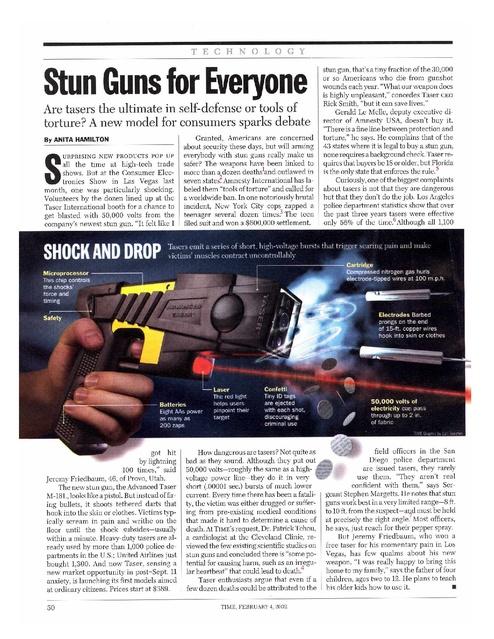Table of Contents
- Understanding the Optimal Duration for Stun Gun Application
- Factors Influencing Effective Stun Gun Use
- Safety Guidelines for Applying a Stun Gun
- Expert Recommendations for Maximizing Stun Gun Impact
- To Wrap It Up
Understanding the Optimal Duration for Stun Gun Application
Determining the appropriate duration for stun gun application is critical to ensure both effectiveness and safety. Typically, a brief, controlled burst lasting between 1 to 3 seconds is sufficient to incapacitate an attacker or threat. Longer durations may increase the risk of injury or unintended harm, while shorter bursts might not deliver enough electrical shock to achieve temporary immobilization. Factors such as the stun gun’s voltage, the individual’s size and physical condition, and the situation’s urgency should all inform the length of application.
When using a stun gun, it’s important to remember these key considerations:
- Target areas: Aim for larger muscle groups like the thighs, abdomen, or back for maximum effect.
- Compliance checking: After the initial burst, observe the subject’s reaction to determine if additional application is necessary.
- Legal regulations: Follow local laws regarding stun gun use to avoid legal complications.
Factors Influencing Effective Stun Gun Use
Several critical elements determine how effectively a stun gun performs in real-world scenarios. Physical characteristics of the target, such as clothing thickness, body mass, and muscle density, can greatly influence the severity and duration of the electric shock delivered. For instance, thick layered clothing can act as an insulator, reducing the stun gun’s penetration and thus requiring a slightly longer application for maximum impact. Additionally, the target’s level of adrenaline and overall resistance to pain also come into play; individuals under extreme stress or intoxication might endure shocks longer than usual, mandating precise control over the stun duration.
Moreover, the stun gun’s technical specifications and proper handling impact effectiveness significantly. The voltage output, probe placement, and contact duration are paramount; optimal results stem from direct probe hits on nerve-rich areas like the torso or thigh rather than attempt-hit at limbs or clothing. Maintaining firm contact for just the right time-typically under 5 seconds but never exceeding 10 seconds-is recommended to incapacitate without causing permanent harm. Mastery over these factors, combined with understanding situational context, ensures that stun gun use is both safe and maximally effective.
- Target’s clothing and body composition
- Volt output and pulse frequency of the stun gun
- Proper probe placement on the target
- Duration and pressure of the stun gun application
- Environmental and situational factors
Safety Guidelines for Applying a Stun Gun
When using a stun gun, prioritizing safety is crucial not only for the person applying it but also for the individual receiving the shock. Always ensure that you have a clear target and avoid striking sensitive areas such as the head, neck, or chest to reduce the risk of serious injury. Wearing gloves and maintaining a firm grip on the device can prevent accidental slips, especially during high-stress situations. Additionally, confirm that the stun gun is fully charged and functioning correctly before any use, as malfunction can lead to unexpected outcomes or reduced effectiveness.
Keep these key practices in mind for safe handling:
- Never apply the stun gun for more than 5 seconds at a time; short bursts are most effective.
- Maintain a minimum distance as recommended by the manufacturer to avoid self-harm.
- Aim for the belt line or lower torso where the electric current can disrupt muscle control effectively.
- Use the stun gun only in justified situations, respecting legal boundaries and ethical considerations.
Expert Recommendations for Maximizing Stun Gun Impact
To achieve the best results when using a stun gun, it’s crucial to focus on precision and timing rather than prolonged application. Short bursts of 1 to 2 seconds are generally sufficient to disrupt the target’s nervous system without causing unnecessary harm. Prolonged exposure can lead to diminished effectiveness and increased risk of injury, so timing your application is key. Additionally, maintaining a firm grip ensures consistent contact, which enhances the stun gun’s ability to deliver a strong, incapacitating shock.
Consider these best practices to maximize impact:
- Target the appropriate areas: Aim for large muscle groups such as the thighs, shoulders, or torso, avoiding the chest and head to reduce severe health risks.
- Use quick reassessment: After the initial burst, visually assess your target’s reaction before applying additional shock.
- Stay within legal limits: Follow local guidelines and regulations to ensure proper use and avoid legal complications.
- Train regularly: Familiarity with your device improves accuracy and confidence during high-stress encounters.
To Wrap It Up
In conclusion, understanding the optimal duration for applying a stun gun is crucial for both safety and effectiveness. While a brief, controlled burst is often sufficient to incapacitate an attacker, prolonged exposure can increase risks and reduce control. Always follow manufacturer guidelines and local laws to ensure responsible use. Remember, the goal is to protect yourself while minimizing harm, so practice proper handling and stay informed. Stay safe out there!Check Our Other Blogs
- StunGun – Your Trusted Source for Stun Guns, Laws, and Self-Defense Tips
- PepperSprayLaws – Your Trusted Resource for Pepper Spray Information
- StunGunLaws – Your Trusted Guide to Stun Gun Legality and Safety





